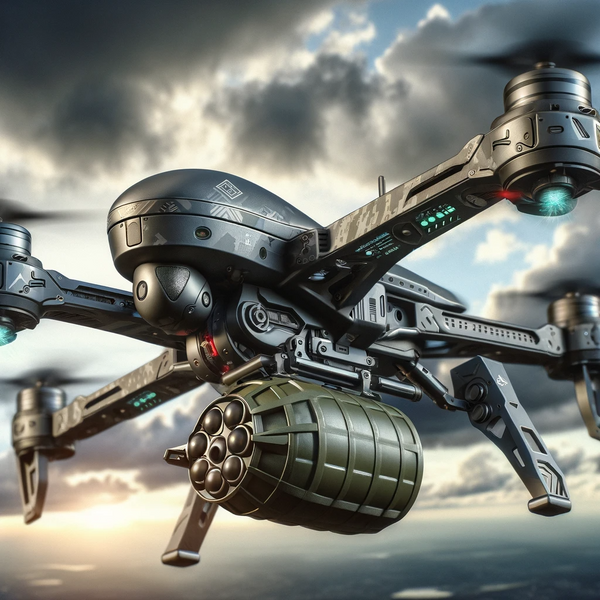Greetings, sky-gazers and tech mavens! Buckle up for a whirlwind tour in today's UMT Drone Dispatch. We're zipping through the skies, from Turkey's export triumphs to Germany's aerial mysteries, and making pit stops at South Korea's defense upgrade and Rio's green revival. It's a global carousel of drone drama, tech marvels, and a few surprises that'll make your propellers spin. Let's get those rotors whirring and dive into the drone world's latest feats and feats!
Turkish Drones Take Flight in Global Defense Market

Turkish drone maker Baykar has soared to the top of the country's export charts with a hefty $1.76 billion in sales abroad, grabbing a lion's share of 32% in the national defense industry's overseas trade. Baykar's CEO Haluk Bayraktar has proudly flagged the Bayraktar TB2 and Akıncı UAVs as the flying aces in this export bonanza. Meanwhile, Haluk Görgün of Turkey's Defense Industry Agency (SBB) has been all cheers about the industry's overall export leap to nearly $5.5 billion, a robust 27.1% year-on-year climb. He's tipping his hat to President Erdoğan for championing the home-grown defense drive. From drones to armored sea dogs, Turkey's defense buffet has tempted 185 countries to sample its 230 varieties of military wares. And let's not forget last year's record-breaking deal with Saudi Arabia, inked during Erdoğan's Gulf tour, which has only upped the ante for Baykar's UAV swagger on the global stage.
Read the full story on Daily Sabah
German Skies: The Unwelcome Drones Amidst Military Maneuvers

The German military has been playing an unwelcome game of cat and mouse with mysterious drones over their training grounds, as highlighted by the Bild newspaper. These unidentified flying objects have been a regular presence, particularly haunting the airspace where Ukrainian soldiers receive training. Despite efforts, including deploying the HP 47 jamming transmitter, the Bundeswehr, Germany's army, has failed to capture any of these elusive drones or their operators. The lack of concrete results has raised concerns, especially since the sightings often occur in clusters, suggesting a coordinated effort potentially linked to Russian espionage activities.
The issue has escalated to the point where a dedicated Drone Task Force was established under the leadership of Army Brigadier General Wolfgang Jordan. Yet, even with this specialized unit, no significant progress has been reported in the last two months. The persistent drone appearances and the inability to effectively counter them underscore the challenges modern militaries face in protecting sensitive information and maintaining operational security against low-cost, high-tech surveillance tools like drones.
Seoul's New Sky Sentinels: Hanwha's Anti-Drone Tech

In a move that's set to bolster South Korea's defenses against aerial nuisances from the North, Hanwha Systems Co.—the aerospace and defense arm of the Hanwha conglomerate—is gearing up to deploy a military-grade anti-drone system. With a hefty price tag of 35 billion won ($26.9 million), the deal with the Defense Acquisition Program Administration (DAPA) will see the establishment of integrated anti-drone facilities designed to detect and disrupt the pesky UAVs threatening key infrastructures such as airports. This marks the first time South Korea will be fielding such technology, featuring jamming capabilities to send the unwanted flying visitors off-course or to crash land. And the cherry on top? Hanwha Systems is not just stopping at home defense; they're eyeing the global market with plans to develop a smorgasbord of export-ready anti-drone models.
The company's strategy includes kitting out South Korean forces with 22 sets of jamming systems, particularly around the Seoul metropolitan area and Air Force airfields, which are in dire need of such protection. This decision comes hot on the heels of a recent North Korean drone infiltration—clearly, a wake-up call for Seoul. The system is a tech buffet, with detection radar, thermal observation devices, jammers, and an integrated console. Plus, there's also a separate deal to roll out 33 sets of vehicle-mounted systems by December 2024, ensuring that the South Korean forces can play a high-stakes game of "capture the drone" with real-time target info sharing. With the drone operation command already launched last September, it seems Hanwha is leading the charge to keep South Korea's skies clear of unwelcome flying objects.
Rio Takes to the Skies for Green Revival

In a bid to beat the heat and give urban greenery a new lease on life, Rio de Janeiro is turning to tech. French startup Morfo's drones are the city's latest recruits in a reforestation initiative aimed at the beleaguered Floresta da Posse. These airborne allies are redefining the reforestation game, promising to plant a plethora of native trees—up to 20 different species—at a pace that leaves traditional methods in the dust. In fact, we're talking about a reforestation rate that's a whopping 50 times faster than the old-school approach.
But it's not just about speed. Morfo's drones are ditching the nursery, opting instead for pre-germinated seed capsules that they can launch at a staggering 180 per minute. This not only cuts costs significantly but also ensures pinpoint planting precision. The project is also a step towards the digital era for Rio's reclamation efforts, with the digitized mapping of areas offering invaluable data for ongoing and future greening projects. Although it will take a few years for the trees to reach their leafy potential, Rio's investment of BRL 27,000 is a clear sign that the city is serious about tackling urban deforestation and the urban heat island effect, all while embracing an eco-friendly and efficient tech solution.
Read the full story on ISP Today
Drones Just Got More Bang: AeroVironment's VAPOR 55 MX Hits Targets with Shryke Munitions

In a display of aerial firepower, AeroVironment, Inc. has teamed up with Corvid and L3Harris Technologies to pull off the first successful multi-drop, live fire mission using GPS-guided Shryke munitions from the VAPOR® 55 MX drone. The all-electric UAS flexed its muscles by carrying and accurately deploying four rounds, showcasing Shryke's potent 40mm anti-armor warheads with low collateral damage. Kyle Bowen of Corvid highlighted the munition's suitability for the VAPOR 55 MX, emphasizing its light weight and lethal impact.
The collaboration doesn't just pack a punch; it also boasts precision and safety. Shryke's ability to stay within 1-2 meters of its target is matched with a MIL-STD-1316 ESAD from L3Harris to ensure secure initiation and recovery. Jason Wright from AeroVironment points out the edge they gain from integrating the Shryke payload seamlessly with the drone's Modular Open Systems Approach (MOSA) design. This design choice not only delivers a market advantage but also maintains the commitment to rapid integration for combat scenarios. The VAPOR 55 MX's open architecture further sweetens the deal, allowing for flexible third-party payload integration without the usual costs and delays.
Atlantic Aviation Supercharges Electric Flight with BETA Tech Collaboration

Atlantic Aviation is making a buzz in the aviation world by partnering with BETA Technologies to electrify the skies. They've already powered up Elmira Regional Airport with a shiny new electric charging station, and three more are on the way. This isn't just any charger; it's a versatile beast that can juice up BETA's own ALIA aircraft and even some ground vehicles.
John Redcay of Atlantic is all about embracing a tech-agnostic future, and Nate Ward from BETA is thrilled to have them on board to push the electric dream across North America. With chargers popping up from Vermont to Arkansas, including a Department of Defense first at Duke Field, they're on track to make electric air travel the new norm by 2025.
This dynamic duo isn't just building chargers; they're crafting a blueprint for future FBO-OEM partnerships. The goal? To stitch together an electric network that's as seamless as it is sustainable, reconnecting communities and revolutionizing regional air mobility.
Read the electrifying full story here
Swiss Skies: The Silicon Valley of Robotics

Boasting a leading position in drone core technology and commercial applications, the Greater Zurich Area has earned the moniker of the "Silicon Valley of Robotics." With top-tier institutions like ETH Zurich and the University of Zurich, a thriving developer community, numerous drone manufacturers, and supportive authorities, Switzerland is soaring in the drone sector. The region is not just a hub for research but also a cradle for world-class talent, with universities churning out highly-skilled engineers.
The synergy between academia and industry is a key feature of the region's success, exemplified by initiatives such as the National Center of Competence in Research (NCCR) for Robotics, which fosters collaboration and innovation. This ecosystem is ripe for companies looking to dive into the advanced world of drone technology, with the Greater Zurich Area offering free, tailor-made services to assist in business expansion. So, if you're ready to take flight in the Silicon Valley of Robotics, the Greater Zurich Area is calling.
Read the full article on the Greater Zurich Area's drone prowess
Drone Warfare Leaps Forward with SONGAR's Heavier Caliber Test

In a significant development for unmanned combat aerial vehicles, the SONGAR drone has successfully been tested with a new 7.62 mm gun ammunition version. This advancement was the result of a collaboration between Sarsılmaz and Asisguard. The test marked the first time the SONGAR drone was equipped with a heavier caliber weapon, specifically the SAR 15T, a domestic infantry rifle that promises to extend the drone's firing range to 400 meters — a substantial increase from the previous 100 meters when outfitted with 5.56×45 mm caliber rifles. This increased range is not just a boost in firepower; it's a strategic enhancement designed to reduce the drone's vulnerability to enemy fire.
Tidbits: Did You Know?
- Eco-Friendly Skies: Rio's drone-led reforestation project is not just fast; it's precise. These drones are planting a future forest at a rate of 180 seed capsules per minute. That's greening at the speed of flight!
- Global Defense Drones: Turkey's Baykar isn't just flying high; it's flying far. With sales in 185 countries, these drones are more popular than some pop stars
As we touch down from today's aerial journey, remember that in the world of drones, each flight not only charts new skies but also redraws the boundaries of innovation and intrigue. Until tomorrow, keep your eyes to the skies and your minds open to the endless possibilities of drone technology! 🌍✈️







